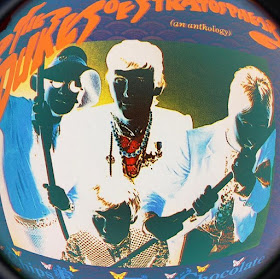
Since their commercial manufacturing, Fisheye lenses have introduced a new lexicon in the grammar of communication design. In particular, since the early 1960s, this lexicon has been widely utilized by graphic designers in the creation of album covers.
During the 1960s, the grammar of the old concepts of communication design was challenged by many graphic designers, who needed a more versatile lexicon to communicate the new dynamics of the modern era, which questioned the traditional paradigms and their ethical foundation. In other words, what had been "normal" was disputed on all fronts, and this included the design of communication. The bulging and surprising perspective of the fisheye lens seemed to offer a more appropriate expression for the new anxieties of the time and the ethical sensitivities of a generation disgusted with wars and the commercial exploitation of the masses. New album covers for rock musicians like Jimi Hendrix and Cream seemed to address these concerns.
All along, a few decades later, the potential of fisheye images was explored by artists and a mature understanding of their grammatical use was developed. Unfortunately, however, a tendency to copycat also developed in parallel, similar to that of poor quality writings with the use of mundane concepts, which contaminated this grammar.
A fisheye lens, of course, is a lens that takes an extremely wide angle of view, often 180 °, and appears as a circle in the black photo frame. There are also rectilinear full frame fisheyes, which give a rectangular, not round, image.
More specifically, the fisheye lenses date back to 1906, when the physicist and inventor Robert W. Wood created a prototype fisheye lens from a bucket filled with water that contained a photographic plate, with an aperture through the box made by coating a glass window with opaque film and removing a tiny area for a pinhole; thus light passed through the glass, the pinhole, and the water, to the plate. He wanted to see if he could create the image of the world from the point of view of a fish. A few decades later, his curiosity led to the invention of the first commercial fisheye lens.
Given that, depth of field is controlled by the focal length of a lens and the distance between the subject and the lens,thus fisheye lenses with their short focal length produce an image with a wide depth of field. In contrast, a lens with a long focal length, such as a telephoto, will condense space and produce a shallow depth of field. As the focal length of a lens increases in a telephoto lens, the magnification of the image will also increase and result in more image distortion that decreases depth of field. A fisheye lens has a very small amount of magnification and thus creates a minimum amount of distortion in the image, resulting in a wider depth of field.
Wood did not explicitly describe the concept fisheye view until the second edition of his text in 1914. He not only described how a fish views the above-water world, but also demonstrated the concept, presenting sample images recording a full 180-degree hemisphere. In 1922, Bond published details of how he eliminated the water from the Wood’s fisheye camera, replacing it with a hemisphere of glass. The greatest surprise found in the literature for fisheye lenses and whole sky imaging systems comes from 1923, when Bernhard Schmidt, who later would invent the famous Schmidt Camera, patented a lens systems with a 120-degree field of view.
In 1957, Nikon launched its first "special order" fisheye camera, which was still used primarily for scientific purposes. However, some photographers and photojournalists have used it to capture different scenes and events. And in 1962, Nikon's first consumer fisheye lens hit the market. It quickly became a pop culture phenomenon, and it seems to have stayed that way ever since.
Shortly after, the photojournalists realized that if they used the fisheye lens, they would be able to capture the latent tense energy during high-speed events, transmitting their highly charged tensions mixed with a sense of suspense - events such as demonstrations, political conventions, rocket launches, etc.
However, many album covers from the 1960s featuring images taken with a fisheye lens, such as The Byrds’ Mr. Tambourine Man, The Rolling Stones’ Big Hits (High Tide and Green Grass), Jimi Hendrix Experience’s Are You Experienced that could extract the lion's share of the fisheye lens potentials. They were used in the 1960s in the belief that they made rock stars appear larger than life. In particular, they were used to film the Beatles' performances, and the results captured the frenzied excitement that their music was disseminating at the time. These lenses were also used to convey the ambiance of the almost revolutionary era of that decade, including the Woodstock festival.



-------------------------------------------------------------------------------
This work is licensed under a Creative Commons Attribution-No Derivative Works 3.0 Unported License.













No comments:
Post a Comment